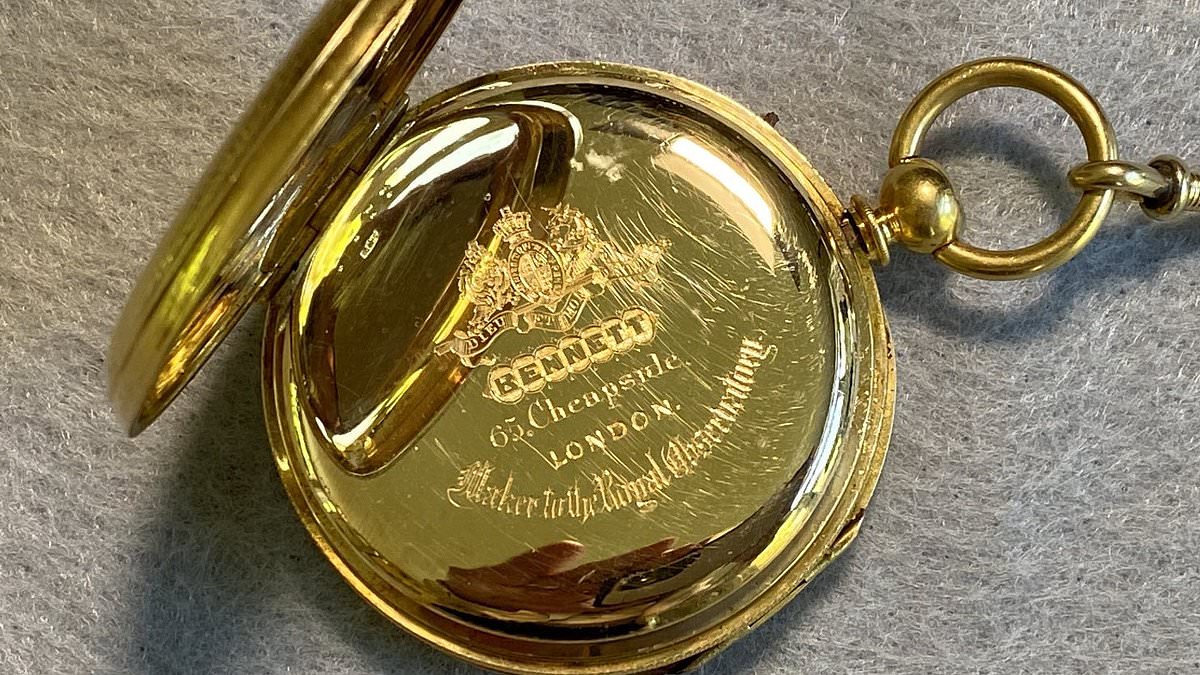After lying hidden beneath the depths of Lake Michigan for over a century, a historic gold pocket watch – lost in a deadly shipwreck – has finally made it home to the United Kingdom.
In the dead of night in 1860, the steamship Lady Elgin collided with another vessel, plunging into the frigid waters of Lake Michigan and dragging 300 souls to a watery grave in what remains the deadliest shipwreck in Great Lakes history, BBC reported.
Then, in 1992, while exploring the wreckage off the Illinois shore, divers made a remarkable discovery – nestled among the remains lay a gold pocket watch, still attached to its chain and fob.
But this was no ordinary chain – engraved with the initials ‘H.I.,’ it once belonged to Herbert Ingram, a prominent British journalist and politician.
Now, 165 years after the tragic sinking, the piece of history has returned to Boston, Lincolnshire – near Ingram’s hometown – where it will take its rightful place on display at the Boston Guildhall museum.
‘Returning this watch is the right thing to do,’ Holland-based historian and author Valerie van Heest told Fox 17 News.
‘This is reminding people that shipwrecks affected people, affected families, and this shows that 165 years later, we care,’ she added.
‘People care about the individuals lost.’
On the night of September 8, 1860, Lady Elgin was making her return voyage to Milwaukee from Chicago, carrying a group of mostly Irish passengers, when a violent storm swept across the lake.
In the darkness, the Lady Elgin was struck by the Augusta – an unlit and overloaded schooner – sending hundreds to their deaths in just minutes.
Among the lives lost in the wreck were Ingram and his son, whose bodies were later recovered and returned to Britain for burial.
Ingram was a prominent public figure – instrumental in bringing fresh water, gas and railway connections to the community, as reported by the BBC.
‘He was a member of parliament,’ van Heest told Fox 17.
‘He was also the founder of the London Illustrated News, which was the first time a newspaper printed images in the paper,’ she added.
‘So he was really the founder of pictorial journalism.’
All that remained of that fateful night were fragments of the Lady Elgin, scattered across nearly a mile of the lakebed – silent echoes of tragedy that van Heest’s team began documenting back in 1992.
But her team wasn’t the only group drawn to the century-old wreckage, as other divers were also exploring the site.
‘The location had leaked, and a trio of divers I have just recently learned, came upon a pocket watch,’ van Heest told Fox News.
‘A gold pocket watch, an extraordinary discovery.’
Remarkably, the long-lost artifact was found in relatively good condition, with experts attributing its preservation to the lake’s cold, low-oxygen depths, which helped prevent significant corrosion over the years, People reported.
However, for more than 30 years, the divers guarded the discovery of the 16-carat pocket watch in complete secrecy, keeping its existence hidden from the world.
Eventually, the divers cleaned the watch and reached out to van Heest.
Through her research, she found that Ingram’s descendants were still alive in England, and that the museum in his hometown was preparing an exhibit about his legacy, as reported by Fox.
‘I very quickly came to the realization it doesn’t belong in America,’ van Heest told the BBC.
‘It belongs in Boston where Herbert Ingram was from, where a statue of him still stands,’ she added.
She then got in contact with the Boston Guildhall museum and personally acquired the watch, determined to donate it as a gift to the town.
‘So many people lost their lives within minutes of hitting the water,’ van Heest told Fox 17.
‘They didn’t have any personal artifacts, and here I was offering not only an artifact, but Herbert Ingram’s personal watch,’ she added.
‘It was an extraordinary, serendipitous occurrence.’
In a statement about van Heest’s offering, the museum’s arts and heritage manager, Luke Skeritt, said: ‘This find is truly a once-in-a-lifetime discovery’.
‘The sort of thing you read about in textbooks and not something you expect to read in an email on a mid-week working day.’
